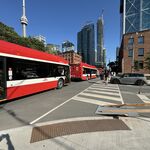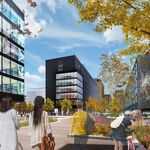salsa
Senior Member
See much time you can shave off of your commute with John Tory:
Although I don't think it takes 19 minutes to get from St. George to Union.
http://smarttracker.ca/
How did you get 19 minutes?
See much time you can shave off of your commute with John Tory:
Although I don't think it takes 19 minutes to get from St. George to Union.
http://smarttracker.ca/
Hypothetical situation...
What are people's thoughts if a Mayor Tory announced that Sheppard East won't be continued due to hopes that the subway will eventually be extended instead. In return, the Finch LRT will be fully-built from Finch (on the Yonge line) all the way to Humber College?
BRT won't save any money on Sheppard East. BRT is more expensive to operate than LRT.
Well, kinda.
BRT can save money (or LRT can be done much cheaper) by having the Don Mills stop on the surface and not widening the bridge or tunnelling below the 404; operate in mixed traffic or reassign them as Bus/Tram only.
This, of course, has a severe penalty on the transfer which was to be extremely easy and will greatly reduce the speed if mixed traffic is chosen.
Well, kinda.
BRT can save money (or LRT can be done much cheaper) by having the Don Mills stop on the surface and not widening the bridge or tunnelling below the 404; operate in mixed traffic or reassign them as Bus/Tram only.
This, of course, has a severe penalty on the transfer which was to be extremely easy and will greatly reduce the speed if mixed traffic is chosen.
Rob Ford has withdrawn from race for mayor.
Yes but someone else is gonna use those "Ford for Mayor" signs...no?
This kind of voting will keep happening even after the first LRTs come into service. Eventually transit advocates and the chattering classes might just begin to understand that the voters actually care about getting home sooner and not about some urban development vision.
Just calling it like is.....
I agree wholeheartedly with this sentiment (even if I would like to use these opportunities for some of that urban development vision) but that is why LRTs are being proposed for certain transit corridors. LRTs need to stop being treated as some lower class form of transit and need to start being treated as a viable form of transit for certain routes, and a faster, more reliable and cozier alternative to buses.
I think the opening of Eglinton will do wonders for the image of LRTs in the city, and soon after we will be wanting to put LRTs everywhere.




